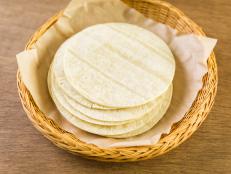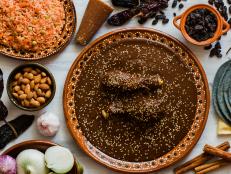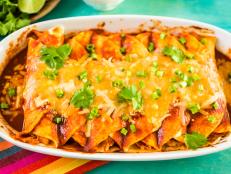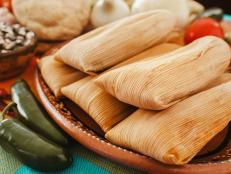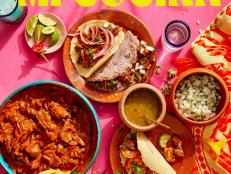Traditional Mexican Recipes
Beyond tacos and tostadas: true south-of-the-border fare
Mexican cuisine is much more than tacos and burritos. It's every bit as varied as most cuisines, although you wouldn't know that if all you've eaten is Taco Bell and Chili's. Coastal regions lean heavily on seafood, while in northern areas, where cattle is king, the cow is relied upon — all of the cow. Some places swim in tropical flavors — papaya and mango, habañero peppers and yucca. Other parts of Mexico take enormous care with their range of mole sauces. Where Tex-Mex is confined to a relatively tight corral of dishes, the food of Mexico is a wide-open range.
Soups and Stews
Few, if any, cuisines shrink from soups and stews. Mexican is no exception. Posole, a warm ambrosia of hominy, pork, green chile and chicken broth, belongs in every cook's repertoire. Everybody (well, most of us) loves meatballs, and albondigas gives you a most excellent combination: meatballs and soup. Many cuisines thrill to bits of bread in their soup — think dumplings. In Mexico, it's popular to sprinkle soups with shredded tortillas, giving us the aptly named tortilla soup.
Casseroles
Mexican noodle casserole uses fried pasta — called fideo — to add heft to a mix of vegetables, broth, meat and cheese, which is baked until bubbly. Corn tortillas obviously figure large in the Mexican pantry, and they are leveraged in chilaquiles con pollo, or tortilla casserole with chicken breast.
Chicken
Mexican chicken can be slathered in adobo sauce and grilled, stewed with chiles, baked with mole sauce, shredded and added to everything: tacos, enchiladas, burritos and more. Chicken mole has many variations across Mexico. In the Yucatan Peninsula, chicken is marinated in citrus, banana, herbs and spices, and grilled. Mexicans cook rice too, of course, and arroz con pollo — chicken with rice — is a classic.
- Chicken Enchiladas with Roasted Tomatillo Chile Salsa
- 'Easiest Ever' Chicken Mole Enchiladas
- Chicken Flautas with Avocado Cream
Seafood
In the Mexican food most of us in North America grew up with, seafood is entirely absent. But in Mexico, particularly if you're near a coastline (Mexico has several), seafood rules. Shrimp are everywhere, frequently lathered in spices and grilled or eaten as shrimp cocktail with a chile dipping sauce. Fish tacos are staples in Mexico as well as Southern California. Whole fish is common too, including Veracruz style: perfumed with lime, oregano and garlic, shrouded in tomatoes, studded with olives, pickled jalapenos and capers, drizzled with olive oil, and more.
Beef
Tacos, burritos, enchiladas and the rest of the Mexican standards often rely on beef, which in Mexico is usually shredded rather than ground. Short ribs can get a royal treatment, marinated in chiles, vinegar, herbs and spices, and then grilled. Carne asada — flank or skirt steak marinated in citrus, jalapeno, garlic and olive oil, and grilled — is another Mexican standby that you should master.
Pork
Carnitas is cubed pork shoulder that is slow roasted — for hours — then finished in a pot of hot lard, making them crispy on the outside and succulent everywhere else. Carnitas are used as fillings for tacos, burritos and other dishes, and they're great by themselves. Pork also gets paired with mole sauces, and it's the standard filling for tamales.
- Fried Crisp Pork with Chile-Peanut Sauce: Carnitas con Salsa Guajillo y Cacahuates
- Traditional Pork Tamales
Salsa Central
The spicy sauce we buy in jars on supermarket shelves used to taste all the same, but now, at least, there are choices beyond mild, medium and hot. There is green salsa, and salsa punched up with chipotle. You can find habanero-smacked salsa, garlic-heavy salsa and roasted tomatillo salsa. And in Mexico, of course, there are more salsas than could fit in an entire aisle of one of our grocery stores. But then again, in Mexico most of them aren't things you buy in jars; they are things you make.
Salsa means "sauce" in Spanish. Which means it's a much broader category than the thing usually plonked on the table at a Mexican restaurant: a blend of tomatoes, onions, peppers and cilantro. In Mexico — and increasingly in the United States — a salsa comes either raw or cooked, and its based on either red tomatoes or tomatillos, a cousin to the red tomato that is green and comes off the vine encased in a papery shell.
There's nothing wrong with the standard-issue blend of tomatoes, onions, peppers and cilantro. It can be sublime. But the same goes for an earthy, cooked tomatillo salsa with dried arbol chiles, or a salsa ranchera, a mix of roasted tomatoes and onions, fresh chiles, vinegar and more. Even guacamole counts as salsa, as well as mole. If you really want to understand Mexican food, to dive into the cuisine and make it something you can explore a few times a week without growing bored (Not burritos again!), then start practicing with salsas.
Desserts
Many Mexican desserts trace their origins to Spain; dessert was a European concept brought over by the Spaniards and not part of the pre-Columbian diet. In modern Mexican restaurants and homes, meals are finished with puddings, candies and the ever-present flan, featuring new-world flavors of tropical fruits, like coconut, guava and mango, and spiced up with cinnamon or chocolate.


























